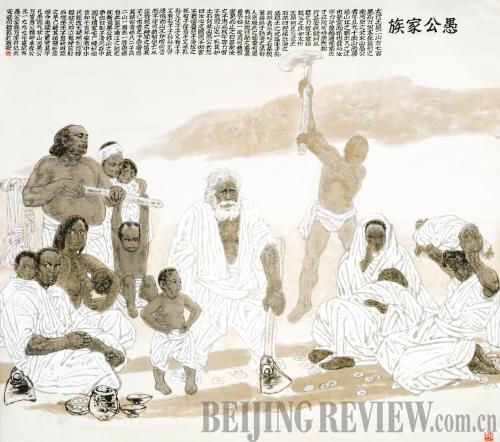 |
|
Yugong's Family, a painting based on a Chinese fable in which Yugong (literally, "foolish old man") and his family members attempt to move a mountain |
What do you think about the influence of Western art in China?
For the past 100-plus years, Chinese art has followed the footprints of Western art, which has changed our artistic conceptions and techniques. At the same time, it has helped the aesthetic demands of Chinese people evolve. But this is not to overlook the fact that national traditions, especially our traditional artistic spirit, have been ignored. We have kept some traditional techniques, but the study of Chinese art is far from sufficient. Although we've noticed this issue, it cannot be changed in one day.
For years we have been learning from the West and many of our artists started their journeys learning from Western art. The works they produce now turn out to be a combination of the West and the East, or even Western-oriented. This kind of imbalance is hard to change. However, we need to enhance our artistic awareness and national confidence, both of which can be achieved through the efforts of artists, through government assistance, and more importantly, through education that focuses on traditional culture.
Could you give us a brief introduction to the China National Academy of Painting?
It took us five years to re-organize an art research institute that focused solely on traditional Chinese painting into the China National Academy of Painting, extending it into the fields of calligraphy, oil painting, printmaking, sculpture, art appreciation and public art exhibits. Eight institutes were established to support development in those fields, in addition to a youth academy for young artists. Meanwhile, five research centers specializing in art education, the art industry, information, communication and modern art are collaborating with those eight institutes in order to pick up any slack and make their work more accessible to society. We also work with domestic and overseas organizations to set up institutions both at home and abroad. The results of our artistic mission will be spread through those institutions, and thus have a greater impact on society.
Email us at: yanwei@bjreview.com
 |
|
Yang Xiaoyang (left) is named an honorary academician of the Russian Academy of Arts (COURTESY OF YANG XIAOYANG) |
Profile
Yang Xiaoyang was born into a family of artists in Xi'an, northwest China's Shaanxi Province, in 1958. He earned both his bachelor's and master's degrees at the Xi'an Academy of Fine Arts. He then joined the faculty and assumed the position of president in 1997. Now, as head of the Beijing-based China National Academy of Painting, he is leading the development of Chinese fine arts. In July 2014, along with a delegation of Chinese artists, he paid a visit to Russia, where he was appointed an honorary academician of the Russian Academy of Arts. |
